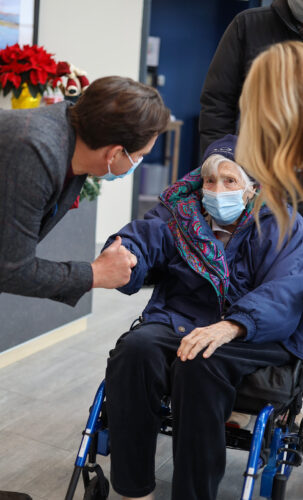Opening a new LTC Home takes planning, purpose and partnerships
With 40,000 people waiting for long-term care in Ontario, it’s no wonder building and opening new long-term care homes quickly is a top priority for government and senior living organizations alike.
peopleCare Communities – a family-owned, values-based leading operator of long-term care and retirement homes – is doing our part. Working hard to accelerate the nine long-term care developments currently in our pipeline, we anticipate getting shovels in the ground in multiple communities in 2023 alone.
Opening a brand-new long-term care home is a significant undertaking, which made it all the more satisfying to see the happy smiles on residents’ faces this past December as we welcomed them into their new 128-bed home in Meaford, Ontario, with special guests and a ribbon-cutting in front of the holiday tree.
“The whole experience was fantastic,” says family member Bernice Rennie, whose mother Margaret lives in the home. “The staff were incredibly helpful and I know my mom didn’t feel any of the stress that may have been going on behind the scenes. When I left that day, I knew mom was in good hands and the staff said she had a great sleep that night in her new room.”
The secret behind the smiles? Careful planning, a steadfast focus on our resident-centred purpose, and our team pulling together with our family, community and government partners. All were instrumental in helping us hire and orient dozens of new staff, pass our pre-occupancy review, organize an enjoyable move-day experience with minimal disruption for residents, and meet our occupancy targets within the first 60 days of operation.

peopleCare President and CEO Brent Gingerich welcomes Ilona Singer into her new home
Planning: Do sweat the small stuff
There’s a saying about failing to plan. We knew that developing Meaford Long-Term Care Centre, and the other projects in our pipeline, required us to be strategic and set the organization up for sustained success. Key areas of focus included building in-house project management capacity and enhancing our existing network of external development partners and consultants.
“It had been some time since we opened a new home and so we took the opportunity to be very thoughtful and thorough in our planning,” says peopleCare’s Chief Financial Officer Iuliana Constantin. “This enabled us to deliver the long-term care home in Meaford – in the midst of a pandemic – on time and on budget. And it will ensure we can effectively manage multiple simultaneous projects going forward.”
Laying this type of groundwork also went a long way towards mitigating issues that arose in these last couple of tumultuous years, such as market volatility, supply chain issues, rising construction costs and increased interest rates.
Construction was completed within about 16 months. Planning for the opening, while maintaining existing operations in the old home mere blocks away, took about as long.
Jenn Killing, peopleCare’s Vice President, Quality, Research and Strategic Partnerships, led the opening of the new Meaford Long-Term Care Home. Along with developing an entirely new set of resources to stay organized, focused and on track, she says collaboration was essential throughout all planning stages.
“It was important to involve the right people along the way to help us make decisions that would have a positive impact on both residents and operations,” says Killing. “We tapped into subject matter experts in our own organization and across our sector to leverage learnings and that supported better planning.”
As other long-term care organizations will be aware, the Ministry has prioritized rapidly building new long-term care homes to improve access to quality, resident-centred care and ease hallway health care. This includes enabling development through increased capital funding and modernized processes.
Our Meaford pre-occupancy review took place over several days. Each day, the Ministry team worked closely with our team, asking questions and identifying areas that needed to be addressed. Each night, our team resolved any issues and gathered required information to share back the next morning. The end result was an exemplary review passed with flying colours.
“The Ministry’s new tools and checklist are so valuable to understand how to thoroughly prepare, so we not only met but exceeded their requirements and expectations, which is always our goal,” says Killing. “And we appreciated the spirit of collaboration from their team. We felt they wanted the Home to open as much as we did and were invested in making this a shared success.”
Our best advice from the experience – make sure every inch of the home is 110% ready for occupancy. “Go over and above what’s required. Put toilet paper on every roll, make every single bed,” says Deb Cornell, peopleCare’s Director of Accommodation. “It makes a huge difference knowing anyone could come through the door on inspection day and safely, comfortably live, work or visit in the home.”
Along with move-day planning, a significant amount of time and effort went into preparation of the occupancy plan, worksheets and communication that enabled us to admit 60 new residents in 60 days. That work was led by Wendy Filiatrault, our Director, Clinical Services, alongside the home’s clinical team, with a focus on person-centred care planning, choice and 1:1 support for residents and families.
Working closely with our valued partners at Ontario Health West, the home was full in no time, which speaks to both the effectiveness of our plan, and the growing need for more long-term care in the community. “It was a good day when we filled the home and knew we had 128 residents and all the staff we needed to provide them with meaningful experiences and exceptional care,” says Filiatrault.

A musical performance was scheduled during the Meaford opening to help welcome residents to the new home
Purpose: Keep residents front and centre
As visitors enter the resident home area to the left off of the bright sunny lobby in Meaford, one thing they often notice first is the name: Beautiful Joe Way, and a lovely mural depicting its namesake, a local terrier known as “Canada’s most famous dog.” Residents named all the new home areas with a connection to the community’s landmarks and heritage.
Katrina Tolton, Director of Programs, says this seemingly small gesture had deeper meaning. “Naming the new home areas was a lot of fun and built excitement and anticipation prior to the move,” she says. “And I think it really reflects how we kept the focus on the needs, wishes and preferences of our residents every step of the way.”
Resident Ilona Singer couldn’t be happier with how staff supported her in the transition. “The move went so smoothly, everything was prepared and ready when I got here,” says Ilona. “I was a little sad to leave, but I was happy to see the new home.”
Resident Norma Sonnenburg agrees, “Everyone was so welcoming. And the new home is gorgeous. When I first walked in, I thought wow – that lobby is something else!”
Engaging families was also key. We communicated with families regularly through town halls, emails and phone calls. Families helped their loved one pick out their new rooms (What view? What floor? Near the dining room or lounge? Private or shared? etc.). They also set up the new living space before the move, right down to family photos and mementoes, so residents felt welcomed and immediately more comfortable surrounded by their own belongings.
Every resident received a welcome basket and families enjoyed an inroom picnic lunch with their loved one, topped off with a musical performance. “The entire home was decorated beautifully and the concert was a nice touch,” adds Rennie.

Margaret Ruppel (left), one of Meaford’s first residents, transitioned easily to the new home, which incorporated comfy design elements like an Adirondack chair and scenic walls (right)
Pulling together: All hands on deck
With construction nearing completion, communication and logistics planning for the pre-occupancy review, moveday and admissions kicked into high gear. Fortunately, our team wasn’t going it alone. “Everyone was excited and wanted to help. From families and volunteers to community partners and members of the public. Unions and suppliers to contractors and architects. Successfully opening the Home was a real group effort,” says Killing.
Our supportive municipal partners were always a phone call away to answer questions, help remove barriers and connect us with resources in the community that would benefit residents and staff. Our unions worked with us on new staffing lines and helped welcome and educate new team members. Some neighbours fundraised to buy flower centrepieces for residents to enjoy; others dropped by looking for a tour or more information.
Staff from other peopleCare homes decorated the new Home for the holidays. And the entire Meaford team helped one another manage the balance between excitement and uncertainty. “Moving into the new Home is an adventure for us all,” says Wendy Cochrane, a Recreationist who has worked for Meaford Long-term Care for 30 years. “A change like this is not easy, but I think it’s a wonderful thing to experience because it helps us to grow. And fortunately, we’re a great team and can count on one another in the process.”
To develop the long-term care homes needed to meet the growing demand in Ontario, everyone in the sector and health system is going to have to pull together. In the lead-up to opening Meaford Long-Term Care, peopleCare reached out to other senior living organizations that had successfully opened new homes and all were generous in sharing strategies and insights. Special thanks to Jarlette Health Services, Southbridge Care Homes, and many others. We hope others will do the same. “We fully expect to continue this journey of learning and improvement as we open each of our new long-term care homes in the coming years,” says Killing. “Wherever your organization is on your development journey, pick up the phone and call us anytime. We’re happy to talk about what went well, what surprised us, and what opportunities will help us all build and open more new homes quickly and efficiently.”
Ultimately, the goal is to see all long-term care residents in Ontario flourishing in beautiful, modern new homes with more space, upgraded amenities and exceptional quality of life, Killing adds. Let’s get there together.
Key considerations
Some things to consider from peopleCare’s experience:
- Keep residents front and centre: At every step, ask “How will this impact residents?” Plan accordingly. For instance, ensure residents have 1:1 move-day support but be mindful that too many extra hands might feel chaotic. Schedule residents who like to sleep in on the last bus. Set each room up the way the resident likes it before they arrive. Add a welcome basket. Schedule a popular activity or musical performance in the new lounges. All the little things you incorporate into planning will add up to a big, warm person-centred welcome.
- Involve the right people early on: An approach to planning that maximizes input from the subject matter experts at hand (especially your staff!) helps ensure decisions – from what supplies to buy, to where to put them – make sense from an operational perspective. Engaging residents, families and community partners will also help transform the building into a home.
- Acknowledge that change can be hard: While the benefits of moving to a newer home are many, the anxiety that goes along with the change can be acute. Residents may mourn the loss of familiar surroundings. Staff must get used to different job routines, workstations and coworkers. Be aware of the need for good change management practices, including plenty of opportunities for people to be engaged and share how they’re feeling, so they can work through concerns and really get excited.
- Identify one point person to lead communications with families and volunteers: For some homes, this will be the executive director, for others, the director of programs. What matters most is having established relationships, updated contacts and a commitment to keeping everyone informed – in particular given the evolving and frequent info-sharing needed as opening day approaches.
- Reach out to your sector colleagues: In the lead-up to opening Meaford Long-Term Care, peopleCare reached out to other senior living organizations who had successfully opened new homes and they were generous in sharing tools, strategies and insights.
- Celebrate success along the way: Opening a new long-term care home takes a lot of time, persistence and plain hard work. That’s why celebrating milestones along the way is so important. Inspire positivity by posting construction progress photos. Take time to reflect with everyone on how great it will feel once everyone is enjoying life in the new digs. And don’t forget to write little notes of thanks to team members who contribute above and beyond to your successful development project.
Let’s talk staffing solutions
A decade ago, when peopleCare opened a new long-term care home in London, Ontario, hundreds of people showed up to our advertised job fair – quickly filling the close to 200 positions needed as we built our newest team. Those days are long gone.
Fast forward to our recent experience in small-town Meaford and the prospect of hiring dozens of new personal support workers – plus clinical, dietary, environmental and other support service staff – in the midst of an ongoing staffing crunch.
“We knew we needed to get creative, fast,” says Bethany Rupp, Meaford Long-Term Care’s Executive Director (ED). “The traditional ways of getting new staff in the door don’t cut it anymore.”
Rupp speaks from experience. A long-time Meaford resident and former local business owner, she led the drive to build the larger workforce needed to meet the needs of residents in the new home.
Her top tips to consider:
- Invest in dedicated recruitment resources and start early. “Scaling up your workforce at this level isn’t something easily taken on at the side of your desk,” says Rupp. “From generating leads to hiring and orienting new staff, it’s a lot to accomplish. Time is definitely your friend.”
- Pursue multiple recruitment strategies, augmenting the standard community job fairs and traditional job postings with virtual career expos, social media advertising, open houses, imaginative community, staff referral incentives and much more.
- Build a network of meaningful relationships to widen your potential talent pool. Focus on innovative academic partnerships and rewarding student placements. Join the chamber of commerce and foster a robust volunteer base. “Finding ways to give back in the community helps residents stay connected to friends and neighbours and has the added benefit of keeping our home top-of-mind for referrals,” says Rupp.
- Solve for workforce housing, one of the biggest barriers to recruitment and retention (particularly in rural areas). peopleCare secured rental units in Meaford and we are temporarily housing some new staff in our old long-term care home while helping them find other, independent options in the community.
- Tap into your home’s “cheerleaders,” by creating an amazing workplace culture, then asking staff to share their experience through testimonials, mentorships and word-of-mouth. The positive things your existing staff say to their family and friends about working for you is one of your biggest opportunities and will resonate with prospective employees.
- Look outside of Canada, a strategy peopleCare used to add 30 Internationally Educated Nurses (IENs) to our Meaford team. These individuals commit to working in the home for two years and practise as PSWs while working towards their nursing credentials in Ontario. “They’re proving to be an amazing asset in providing great care to residents,” says Rupp. While the hiring process can be lengthy, new funding support from government for initiatives like IEN preceptorships makes this an even more appealing option to recruit skilled new employees.
—
Article written by Sheena Campbell, Vice President of Communications and Engagement at peopleCare Communities. First published in the Spring-Summer 2023 issue of OLTCA’s magazine, Long Term Care Today, available here.
Printable version of article available here.

